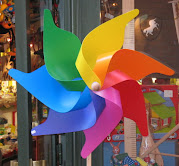Where are you with the Easter story?
Are you still looking at the outline of the three crosses against the sky, wondering about the terrible communal and individual violence that led to a prophetic leader being brutally and slowly publicly executed?
Or are you with the women carrying creative pungently perfumed spices - terrified and shocked to not be able to anoint the dead body in the tomb.
Either way the focus seems to be violence and death.
Yet somehow the words of the two men (were they angels?) dressed in dazzling clothes begin to convince the women that this is not a story about death but about the risen one. The terror is replaced by a remembering of what Jesus said to them while he was with them, and the women leave the tomb of death and tell their story to the eleven who dismiss it as an idle tale.
Yet because the women have dared to listen to the angels,
dared to remember what Jesus said to them while he was alive,
dared to return to relationship and to tell their story in the face of ridicule,
the story of the resurrection gets out of the tomb
And there's something about the idle story that sets Peter's feet running
Something about the grave clothes that makes him wonder …
Was it really just an idle tale?
Christ's resurrection was never a conjuring trick with bones
but was always about the triumph of relationship, humility, beauty, audacity and creativity over the obsession with death and violence.
The Canadian theologian and Quaker Grace Jantzen begins her highly erudite and very intuitive book Foundations of Violence: Death and the Displacement of Beauty by telling this story and asking these questions:
"At the height of the bombardment of Sarajevo, so the story goes, a string quartet visited that city. One morning, as bombs were falling, the cellist look his instrument out into a square and began to play. Soldiers, hearing him, rushed to order him to take shelter, 'You are mad.’ they said; 'get inside. Look! Can't you see what's happening?'
'Yes’ he said. 'Look. Can't you see what's happening? And you say that I am mad?'
Who is mad and who is sane in a world in which beauty confronts death, and violence silences creativity? How can we learn to name what is happening, and find resources for transformation? Where are the springs of hope, that could bring newness and flourishing into a death-dealing world How can newness enter the world? Where may we look to find the resources for redeeming the present?"
Of course the cellist playing did not immediately stop the bombs
And of course perhaps it is just an idle tale and he never really played in the war zone
The resurrection is about beauty and creativity, perfume and tears being the key resources for redeeming the world
So the story of the cellist is still being told
And the story of the bread breaker, foot washer and tomb quitter from Galilee also still goes on
In our language about resurrection we so often get lost in triumphalism,
Talking about the mighty event of the resurrection
Yet actually resurrection is about a remembered promise in an empty tomb
It is by humble word of mouth that the idle story that changes the world will be told
Most of us will not play cello to make beauty sound out while the bombs fall
Though some of us in this amazing international place may have done even more beautiful and audacious things than that
Resurrection is about relatedness,
The joyous beautiful sound of laughter
Random acts of kindness
An encouragement to all of us to go on telling the idle tale
To overcome obsessions with death and violence and to feed Christ's resurrection creativity and beauty back into the world
So where are we now with resurrection?
Still stuck at Good Friday or daring to threaten the world of violence and death with our cello tunes of beauty and creativity against bombs, bullets and stabbings?
Christ is risen, Christ is risen indeed!
Let us in joy greet one another with this Easter affirmation – Alleluia!
Sermon preached in the Ecumenical Centre, Geneva Tuesday 14 April 2009
copyright(c) Jane Stranz/WCC
Further reading:
Grace Jantzen, Foundations of Violence – Death and the Displacement of Beauty, Routledge, 2004.
Janet Lees, Word of Mouth, Wild Goose Publications, 2007.
Kennings and Cookies
On the Vision4Life website
Tuesday, 14 April 2009
An Easter sermon on Luke 24
Publié par Jane à l'adresse 19:40
Libellés : Easter, Feminist theology, peace, sermon
Subscribe to:
Post Comments (Atom)






0 Comments:
Post a Comment